Underground Allies: The Importance of Fungi in Redwood Conservation
illustration by Rebecca Zwanzig, High West Wild.
The World of Fungi
Like all terrestrial forests, redwood forests are both directly and indirectly supported by expansive networks of fungi. All around the world, in soils and organic tissues (logs, leaves, decaying animals, etc.), there are fungi living mostly invisibly. Some species of fungi produce mushrooms, or fruiting bodies, which are the spore-bearing organs of a fungus.
It may be helpful to remember that all mushrooms are fungi, but not all fungi are mushrooms. The term “mushroom” typically means a fungus with a cap and stem, like the common portobello, but is loosely applied to any fungus with a conspicuous, aboveground fruiting body. Fungi can take on numerous forms, from the microscopic, single-cellular yeasts living in our bodies and fermenting our beer to the largest organism known on Earth — a patch of mycelium in eastern Oregon spanning about 10 square kilometers (or ~4 square miles), belonging to a species of honey mushroom, Armillaria ostoyae.
Mycelium (mycelia plural) is a network of fungal cells that move through substrates, seek and digest nutrients, and carry out mating and that can live undetectable to the naked eye for much, if not all, of the individual’s life. It is estimated that in a single thimble of soil, there are 400 meters of fungal cells in the form of mycelia (Christensen, 1989). A mushroom will arise from mycelium, discharge its spores, and then gradually decompose or be consumed by other beings, while the mycelium lives on.
The Many Roles of Fungi
Fungi perform numerous functions, living within both marine and terrestrial systems and in habitats ranging from deserts to rain forests. Fungi provide nourishment directly as a food source to animals, offer habitat for invertebrates and other small creatures, and support new life through nutrient recycling. They break down lignin and cellulose from plant matter and decompose animal remains.
Imagine for a moment that when a tree falls, there are no fungi or bacteria to actively decompose the plant material — very quickly, fallen tree trunks would pile up and cover the landscape, making new tree growth almost impossible.
Amazingly, this exact scenario did once occur on Earth over 300 million years ago, in what we call the Carboniferous period. At this time, the ability for microbes to digest lignin and cellulose had not yet evolved, and this massive accumulation of dead tree material compressed under its own weight and, over time, transformed into coal. The evolution of this digestive capacity is just one way in which fungi and other microbes dramatically alter, enable, and guide life on Earth.
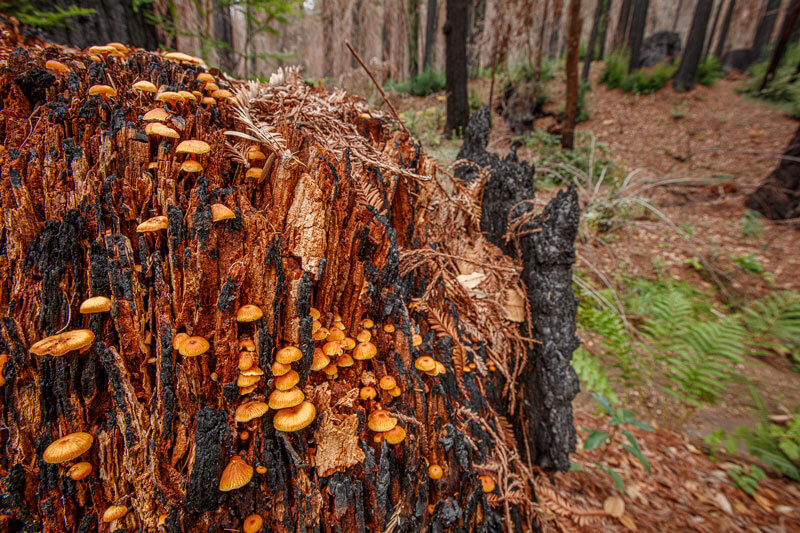
Mushrooms on a charred redwood stump at San Vicente Redwoods By Ian Bornarth.
Fungi also perform a spectrum of symbiotic interactions ranging from parasitism to mutualism, all of which are critical to the biodiversity of habitats around the world. For example, cellulose-digesting fungi have evolved to live in the guts of termites, enabling termites to eat and digest wood. Another type of symbiosis involving fungi is known as mycorrhizae, or mycorrhizal networks.
“Myco” refers to “mycology,” the study of fungi, and “rhiza” means “root.” Mycorrhizae are fungi that form partnerships with over 90% of terrestrial plants, including redwoods. The mycelium can either connect to the roots of the plant or penetrate the plant cells.
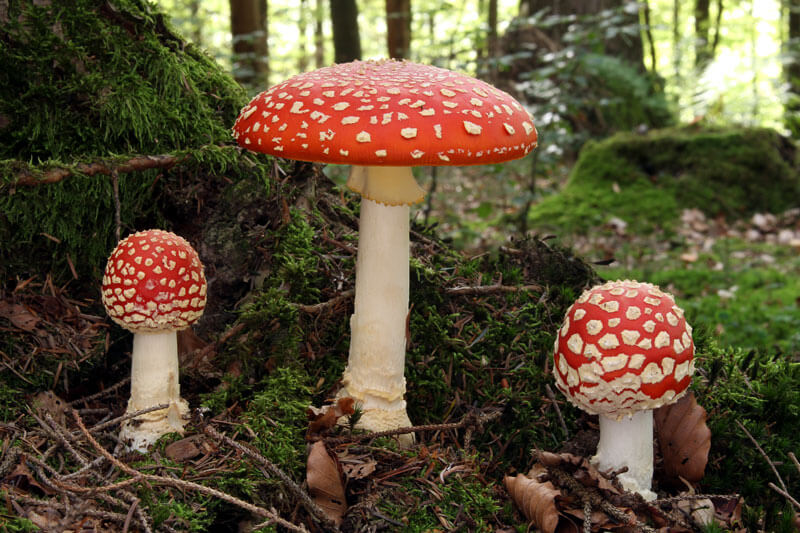
Fly agaric mushrooms, by Holger Krisp.
There are many types of mycorrhizal fungi, some of which produce well-known mushrooms, such as the iconic Amanita muscaria, or the fly agaric mushroom. In these interactions, the fungus provides the plant nutrients, such as nitrogen and phosphorus; water; antimicrobial protections; and an assortment of other benefits that we are still working to fully understand.
In exchange, the plant provides carbon in the form of sugar, which was produced by photosynthesis in the plant tissue. This type of symbiosis is referred to as mutualistic because both partners benefit from the exchange. Plants not only benefit from their fungal partners, but these benefits can be dramatic. For example, in a research study conducted in a tree nursery, seedlings of the giant and coastal redwoods inoculated with known mycorrhizae partners were found to be 2–3 times larger than uninoculated seedlings (Kough et al., 1985; Molina, 1994).
Understanding and promoting the growth of mycorrhizal fungi is essential to the health of redwood forests and is especially critical for regeneration of damaged habitat.
Fossil evidence for a type of mycorrhizal fungus genus called Glomites dates back to the Devonian period, ~400 million years ago, which is the geologic period in which terrestrial plants began to emerge in the fossil record (Taylor et al., 1995). Due to the early fossil evidence and the widespread reliance on these fungi, it is believed that mycorrhizae critically facilitated the transition of plants from the ocean to land. Previously uninhabitable land became accessible to plants through cooperative resource sharing with fungi.
These fundamental partnerships mean that a robust mycological community leads to a healthier, more resilient forest.
Fungal Companions
In the redwood forests and surrounding habitats, there are hundreds of documented species of macro fungi (fungi that form fruiting bodies that are visible without a microscope). These species range from the bright and conspicuous soil-dwelling Leptonia carnea to the modest and oft-overlooked wood-decaying Annulohypoxylon thouarsianum.
There are also several mushroom species in redwood forests that are edible for humans, such as the blewit, Lepista nuda, a light purple and soil-dwelling mushroom. Another is the ubiquitous oyster mushroom, Pleurotus ostreatus, which is not only edible but also famous for its ability to help remediate habitats polluted by fossil fuels by digesting the waste (Akhtar & Amin-ul Mannan, 2020).
At present, the scientific consensus is that there are approximately 3 million species of fungi on planet Earth (Hawksworth & Lücking, 2017). Of that estimate, only about 140,000 species have been formally described by scientists, meaning the vast majority of species remain unnamed (Kirk, 2019). Most of this biodiversity remains in the hyperdiverse habitats, such as tropical rainforests, and in the underexamined microhabitats, such as in caves, aquatic habitats, and in or on the body of other organisms, such as insects and plant leaves (Hawksworth & Lücking, 2017).
Mushrooms of a Redwood Forest
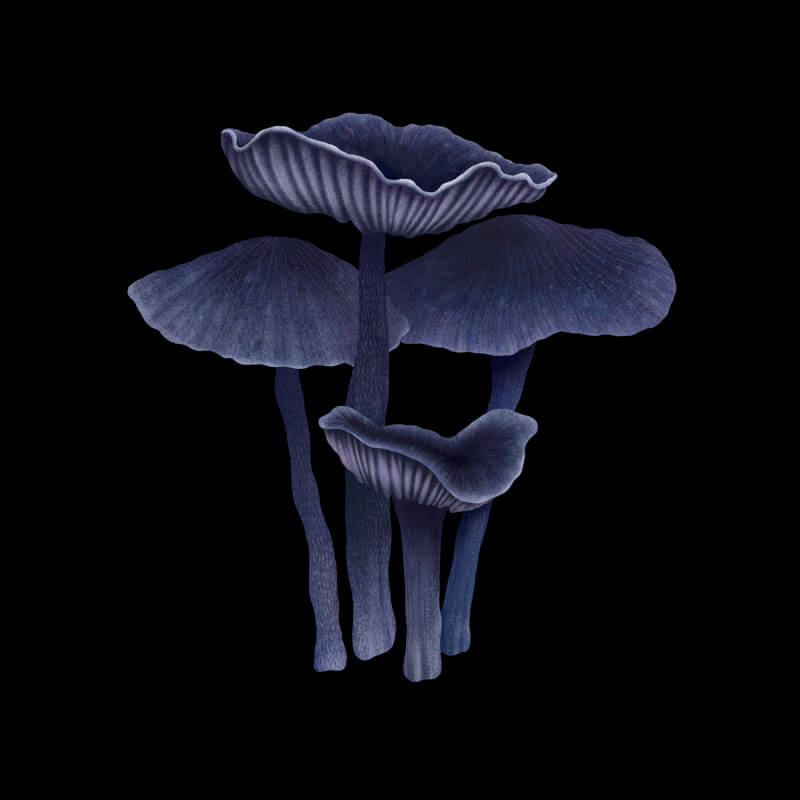
soil-dwelling Leptonia carnea
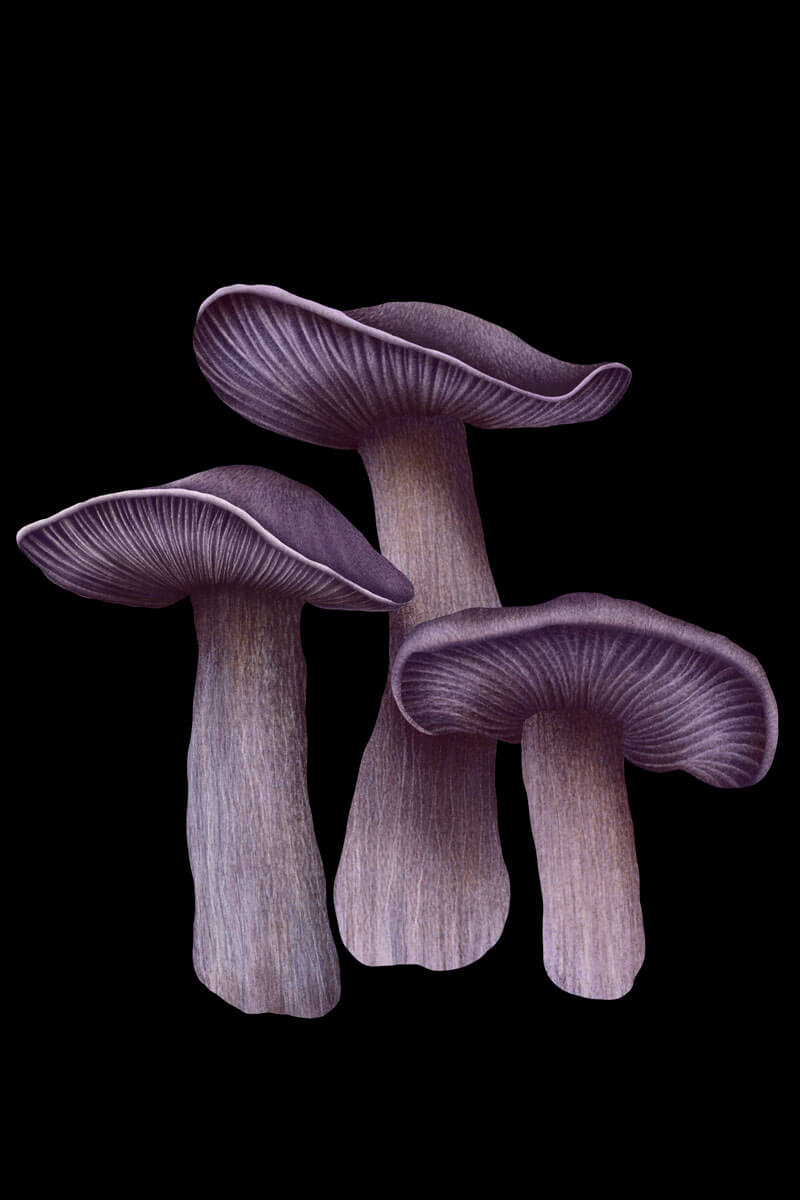
blewit, Leptista nuda
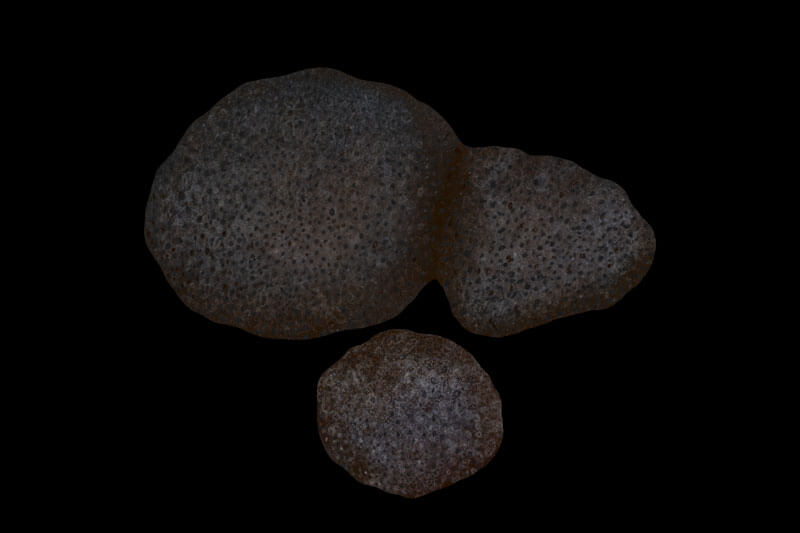
cramp balls, Annulohypoxylon thouarsianum
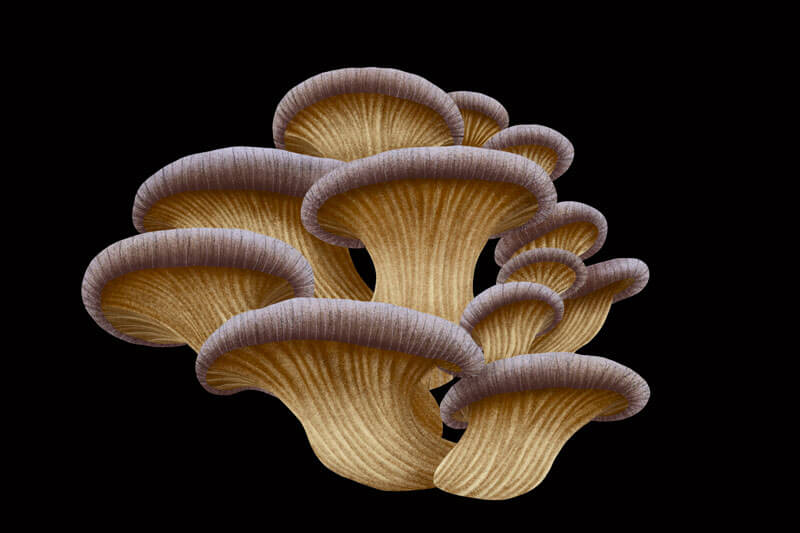
Oyster mushroom, Pleurotus ostreatus
illustrations by Rebecca Zwanzig, High West Wild
Science and Society
Mycology is a powerful case study in the material ways by which science and culture reinforce each other. Fungi have been largely neglected by science and European-American culture, and collectively, they have a reputation for being harmful, poisonous, and pathogenic despite all of their critical ecological functions described above. The explanation for this is not straightforward but is related to the ways in which fungi disrupt the Western cultural values of individualism, predictability, and control. By embodying collective, unpredictable, and uncontrollable biologies, fungi have been perceived as antagonistic, and the priority was not in understanding them but in eradicating them (Kaishian and Djoulakian, 2020).
As much as scientists like to assert that our work is recalcitrant to the political and social influences of our world, it is a plain fact that our studies can be corrupted by human biases, sometimes in very dangerous ways. Perhaps this is most evident in one of science’s most insidious spawns, the eugenics movement.
Eugenics, as a field, has ties to science because it employs a biased understanding of genetics and inheritance in an attempt to prove the biological nature of race and racialized qualities, such as intellect, work ethic, poverty, and criminality. Central to eugenics is the notion of “purity” in genetic material or gene pools.
Eugenics was a popular, widespread movement that was routinely taught in universities throughout much of the 19th and 20th centuries and is still propagated today. This school of thought places a cultural and scientific emphasis on purity and charisma, assigning the highest value to beings that meet arbitrary standards of perfection — concepts that have directly informed and inspired the field of redwood conservation (Allen, 2013). In fact, redwoods became a symbol of self-professed genetic greatness of Europeans.
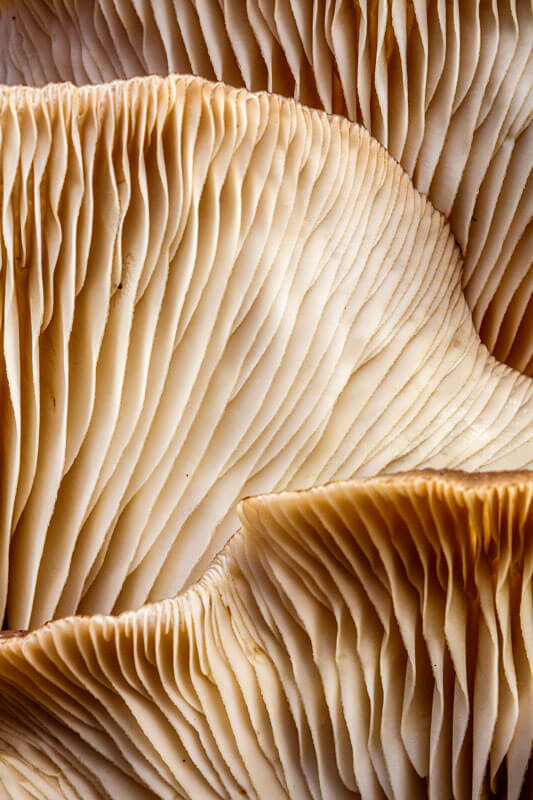
by Ian Bornarth.
This mindset has impeded our understanding of the entangled ecological realities of our own societies and bodies as well as the ecological systems that support the human species. In addition to the enormous human cost of such racist ideologies, there have been profound costs to our biodiversity. For the eugenicists, as well as for cultures influenced by its oppressive dogma, there is a great humiliation in recognizing the shared realities and interdependencies between races and between species.
What would it mean for a society if their accumulated wealth was not due to their inherent greatness but due to the forced labor of others? Similarly, what would it mean to redwood symbology if a redwood grove was not simply sustained by some raw genetic excellence but was critically supported by an underground network of fungi?
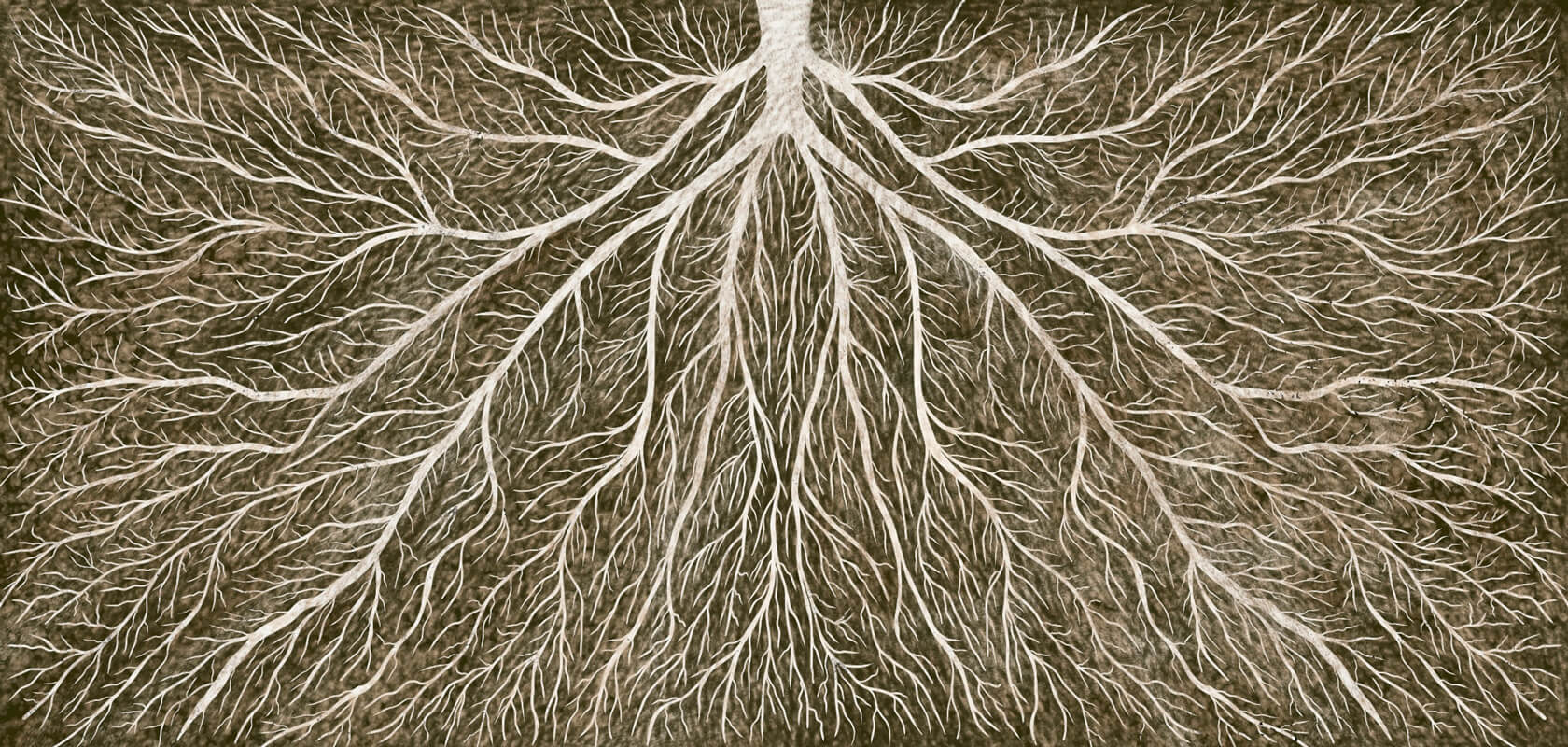
mycelium illustration by Rebecca Zwanzig, High West Wild.
Conservation
The consequences of negative perceptions of fungi are evident. As of 2022, fewer than 600 species of fungi have been evaluated for placement on the International Union for the Conservation of Nature Red List of Threatened Species. By comparison, over 25,000 species of plants and over 68,000 species of animals have been evaluated.
While it may seem like a positive sign to be underrepresented on the endangered species list, this is unfortunately a negative consequence of being under-studied. As a group, fungi are no more immune to the dangers of habitat destruction and climate change than any other group of organisms. Some fungi may be resilient in the face of drought or increased temperatures, but others may be highly sensitive. The difference is that far fewer scientists research fungi compared to other groups, and therefore, fewer resources have been invested in understanding the impacts of climate change on fungal diversity.
As mycologists, we have worked hard to correct this disparity, but we fear we may be losing species to extinction faster than we can describe them or understand the various roles they may be playing in our environment. Fungi need more attention, resources, and care from both scientists and the public. Despite — or perhaps because of — their often-minute size, fungi are integral to the habitats and lifeworlds we call home.
“ Fungi need more attention, resources, and care from both scientists and the public. Despite — or perhaps because of — their often-minute size, fungi are integral to the habitats and lifeworlds we call home.”
— Dr. Patricia J. Kaishian, Ph.D.
Visiting Assistant Professor of Biology, Bard College
Redwood forests are doubtlessly a precious habitat in need of stewardship. This stewardship can only be strengthened by extending our care to fungi and each other. The recent surge in mushroom appreciation is a wonderful opportunity for our planet and our society. We can look to fungi as both a metaphor and collaborators in this process by forming embedded, intercellular bonds that transcend species and decompose notions of purity.
Through their partnerships, fungi exemplify collaboration and interdependence. While they may not evoke descriptors like majestic or glorious from most people, fungi humbly carry out the vital labor of our planet. Protecting and restoring redwood forests involves taking into account the interconnected ecosystem from tallest redwoods to lifeforms even smaller than the tiniest mycelium as Sempervirens Fund’s Natural Resource Manager Beatrix Jiménez-Helsley can attest:
photo by Amanda Krauss.
As we are faced with both climate change and the harmful legacy of eugenics — in the conservation movement, in scientific disciplines, and in culture more broadly — it can be tempting to bury the problem or to look the other way. However, to more fully heal, make amends, commit to reparations, and build sustainable, biodiverse futures, it is essential that the process of reckoning is active.
We must recognize that climate change is fundamentally linked to legacies of colonialism and that the only path forward is one that works to understand these connections. As we move through the challenges of this era, we must think creatively and expansively about how to remediate and myceliate our soils, both literally and figuratively. We cannot do this without fungi.
More to Explore
- Learn more about how fungi help redwoods communicate in Discovering the Wisdom of the Forest with Dr. Suzanne Simard
- Read more about fungi's role in Redwood Fairy Rings and the Magic of Science
- Read more about protecting Redwoods and Flora of the Santa Cruz mountains
Footnotes
Peschel, K. 1998. Puhpohwee for the People: A Narrative Account of Some Uses of Fungi Among the Ahnishinaabeg. LEPS Press. https://books.google.com/books/about/Puhpohwee_for_the_People.html?id=ifJBAAAAIAAJ
Kimmerer, R.W. 2013. Braiding sweetgrass. Milkweed Editions. https://milkweed.org/book/braiding-sweetgrass
References
Allen, G.E. 2013. “Culling the Herd”: Eugenics and the Conservation Movement in the United States, 1900-1940. Journal of the History of Biology, 46(1), 31–72. https://doi.org/10.1007/s10739-011-9317-1
Akhtar N., Amin-ul Mannan M. 2020. Mycoremediation: Expunging environmental pollutants. Biotechnology Reports, 26. https://doi.org/10.1016/j.btre.2020.e00452
Christensen, M. 1989. A view of fungal ecology. Mycologia, 8(1), 1–19. https://doi.org/10.2307/3759446
Hawksworth D., Lücking R. 2017. Fungal diversity revisited: 2.2 to 3.8 million species. Microbiology Spectrum, 5(4). https://doi.org/10.1128/microbiolspec.funk-0052-2016
Kaishian P., Djoulakian H. 2020. The science underground: Mycology as a queer discipline. Catalyst: Feminism, Theory, Technoscience, 6(2), 1–26. https://doi.org/10.28968/cftt.v6i2.33523
Peschel, K. 1998. Puhpohwee for the People: A Narrative Account of Some Uses of Fungi Among the Ahnishinaabeg. LEPS Press. https://books.google.com/books/about/Puhpohwee_for_the_People.html?id=ifJBAAAAIAAJ
Kimmerer, R.W. 2013. Braiding sweetgrass. Milkweed Editions. https://milkweed.org/book/braiding-sweetgrass
Kirk, P.M. 2019. Catalogue of life. http://www.catalogueoflife.org
Kough J.L., Molina R., Linderman R.G. 1985. Mycorrhizal responsiveness of Thuja, Calocedrus, Sequoia, and Sequoiadendron species of western North America. Canadian Journal of Forest Research, 15(6),1049–1054. https://doi.org/10.1139/x85-170
Molina, R. 1994. The role of mycorrhizal symbioses in the health of giant redwoods and other forest ecosystems. USDA Forest Service Pacific Southwest Research Station,151, 78–81. https://www.fs.usda.gov/psw/publications/documents/psw_gtr151/psw_gtr151_12_molina.pdf
Taylor T.N., Remy W., Hass H., Kerp H. 1995. Fossil arbuscular mycorrhizae from the Early Devonian. Mycologia, 87(4), 560–573. https://doi.org/10.2307/3760776

